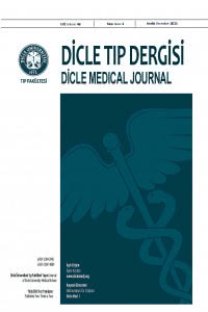The Results of Cross-Linking With Riboflavin/UV-A in Patients With Progressive Keratoconus
korneal çapraz bağlama, keratokonus, korneal topografi
Determining a Safe Time for Oral Intake Following Pediatric Sedation
-,
___
- Kennedy RH, Bourne WM, Dyer JA. A 48-year clinical and epidemiologic study of keratoconus. Am J Ophthalmol 1986;101:267-273.
- Rabinowitz YS. Keratoconus. Surv Ophthalmol 1998;42:297-319.
- Krachmer JH, Feder RS, Belin MW. Keratoconus and related non-inflammatory corneal thinning disorders. Surv Ophthalmol 1984;28:293-322.
- Wollensak G. Crosslinking treatment of progressive keratoconus:
- new hope. Curr Opin Ophthalmol 2006;17:356-360.
- Wollensak G, Spoerl E, Seiler T. Riboflavin/ultraviolet-ainduced
- collagen crosslinking for the treatment of keratoconus. Am J Ophthalmol. 2003;135:620-627.
- Spoerl E, Mrochen M, Sliney D, et al. Safety of UVA riboflavin cross-linking of the cornea. Cornea 2007;26:385-389.
- Wollensak G, Wilsch M, Spoerl E, Seiler T. Collagen fiber diameter in the rabbit cornea after collagen crosslinking by riboflavin/UVA. Cornea 2004;23:503-507.
- Agrawal VB. Corneal collagen cross-linking with riboflavin and ultraviolet - a light for keratoconus: results in Indian eyes. Indian J Ophthalmol. 2009;57:111-114.
- Grewal DS, Brar GS, Jain R, et al. Corneal collagen crosslinking
- using riboflavin and ultraviolet-A light for keratoconus: one-year analysis using Scheimpflug imaging. J Cataract Refract Surg 2009;35:425-432.
- Caporossi A, Baiocchi S, Mazzotta C, et al. Parasurgical
- therapy for keratoconus byriboflavin-ultraviolet type A rays
- induced cross-linking of corneal collagen: preliminary refractive
- results in an Italian study. J Cataract Refract Surg 2006;32:837-845.
- Derakhshan A, Shandiz JH, Ahadi M, et al. Short-term outcomes of collagen crosslinking for early keratoconus. J Ophthalmic Vis Res 2011;6:155-159.
- Gümüş K, Mirza E, Erkılıç K. ve ark. İlerleyici tip keratokonus
- olgularinda riboflavin/UV-A ile çapraz bağlama tedavisinin erken dönem sonuçlari. TOD Derg 2010;40:18-24.
- Raiskup-Wolf F, Hoyer A, Spoerl E, Pillunat LE. Collagen crosslinking with riboflavin and ultraviolet-A light in keratoconus: long-term results. J Cataract Refract Surg 2008;34:796-801.
- Coşkunseven E, Jankov MR, Hafezi F. Contralateral eye study of corneal collagen cross-linking with riboflavin and UVA irradiation in patients with keratoconus. J Refract Surg 2009;25:371-376.
- Caporossi A, Mazzotta C, Baiocchi S, Caporossi T. Longterm results of riboflavin ultraviolet a corneal collagen cross-linking for keratoconus in Italy: the Siena eye cross study. Am J Ophthalmol 2010;149:585-593.
- Mazzotta C, Balestrazzi A, Traversi C. et al. Treatment of progressive keratoconus by riboflavin-UVA-induced crosslinking of corneal collagen.Ultrastructural analysis by Heidelberg Retinal Tomography II invivo confocal microscopy in humans. Cornea 2007;26:390-397.
- Kymionis GD, Diakonis VF, Kalyvianaki M. et al. Oneyear follow-up of corneal confocal microscopy after corneal cross-linking in patients with post laser in situ keratosmileusis ectasia and keratoconus. Am J Ophthalmol 2009;147:774-778.
- ISSN: 1300-2945
- Yayın Aralığı: 4
- Başlangıç: 1963
- Yayıncı: Cahfer GÜLOĞLU
Pediatrik Sedasyon Sonrası Oral Alım için Güvenli Zamanın Belirlenmesi
Yunus ATALAY, Cengiz Kaya, Ersin KOKSAL, Yasemin USTUN, Leman TOMAK
The Association between Symptoms of Obstructive Sleep Apnea Syndrome and School Performance
Melike Demir, Pakize Gamze Bucaktepe, Mahsuk Taylan, Süreyya YILMAZ, Halide Kaya, Mehmet Coşkunsel, Gökhan Kırbaş, Cengizhan Sezgi
Semih KOT, Ayhan SARI, Kenan ÇETİN, Nüvit DURAKER
Atypical Papular Purpuric Eruption Induced by Parvovirus B19 Infection
Şeyma KAYALI, NİLDEN TUYGUN, HALİSE AKÇA, CAN DEMİR KARACAN
Oral Hijyen İndeksi ve Gastrik Helicobacter Pylori Pozitifliği İlişkisi
Tolga ÖNDER, TURGUT ANUK, Cihan HEYBELİ
Göğüs Ağrısı Çocuklardaki Malign Tümörlerin İlk Semptomu Olabilir: İki Olgu Sunumu
Alper AKIN, Meki BİLİCİ, MURAT SÖKER, Bedri ALBUDAK, FATİH METEROĞLU
Priapizm Tedavisinde Bosentan, Teofilin ve Vardenafil Kullanımı
Ihsan Unus, Ahmet Karakeci, Tunc Ozan, Fatih Firdolas, Irfan Orhan
İdiopatik Trombositopenik Purpuralı Bir Olguda Eltrombopag Kullanımı ile İlişkili İskemik İnme
Cranial Magnetic Resonance Imaging Findings of Bonzai Abuse: A Case Report
Veysel BURULDAY, Ural KOÇ, Sinan TAN, MİKAİL İNAL, Murat ALPUS
Zülfü Bayhan, Sezgin Zeren, Mehmet Ekici, Cüneyt Kahraman, Turgay Şimşek
